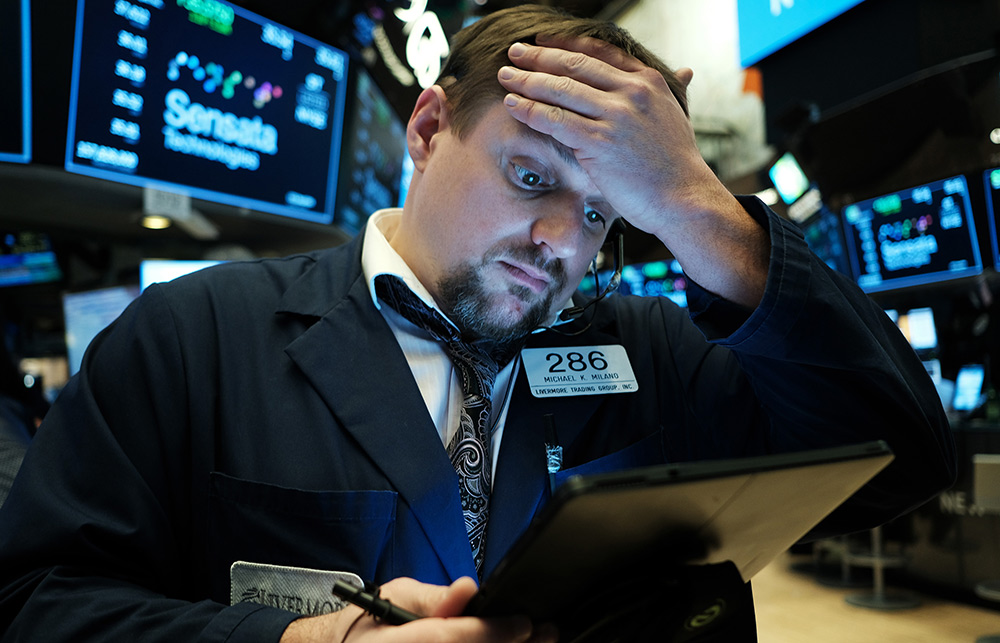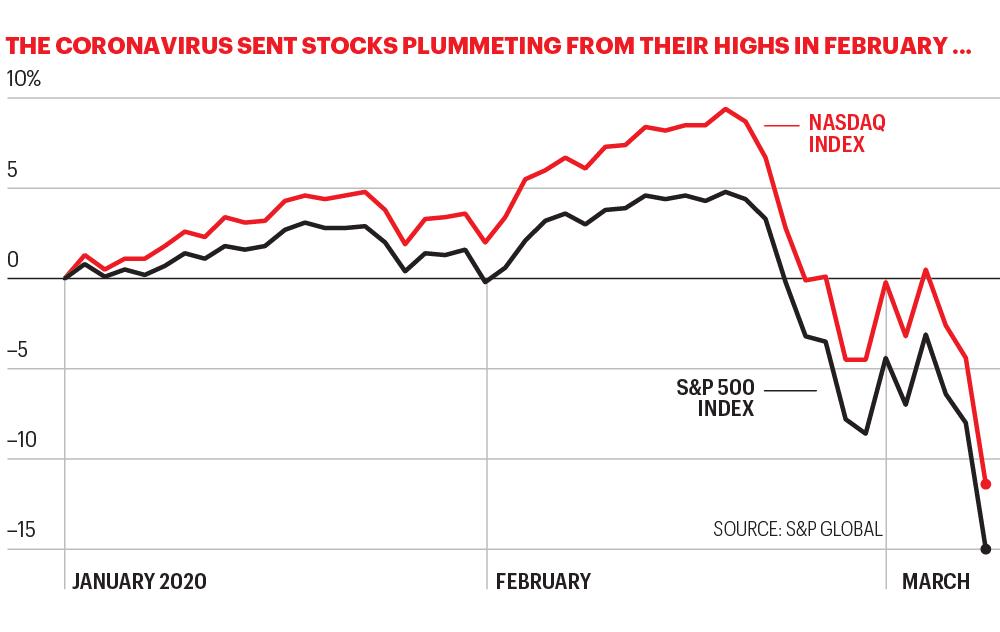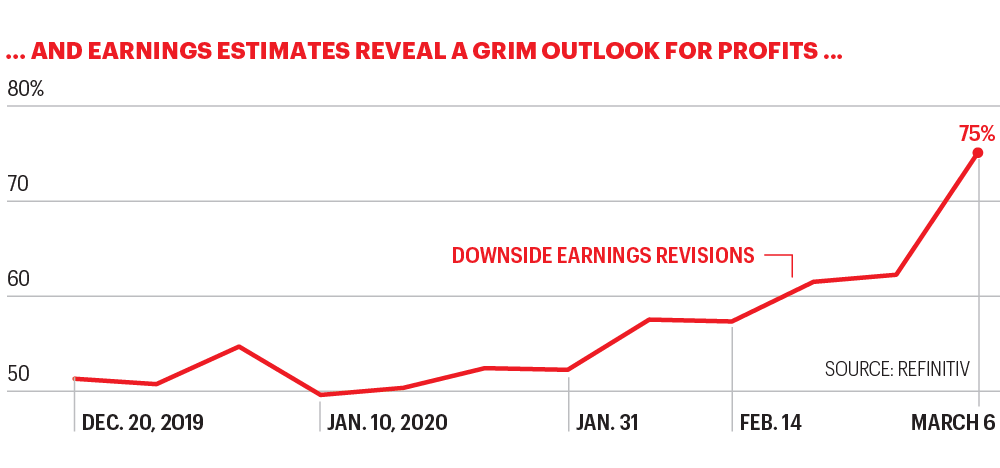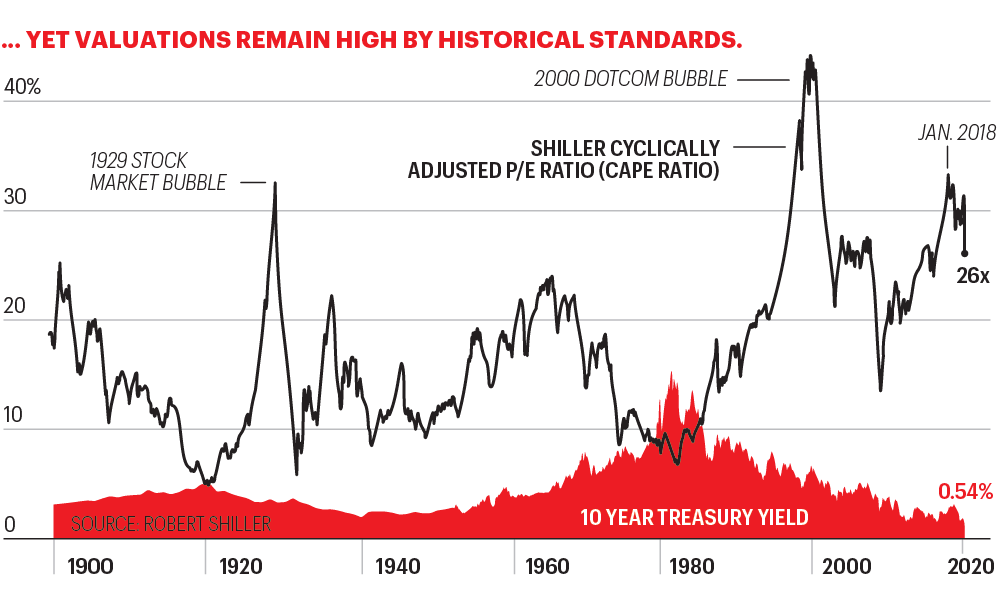
让我们回顾一下局势比较简单的那段时间。
例如,一月和二月。尽管似乎已经有些遥远了,但你或许记得,标准普尔500指数在2月19日创下3394点的历史高点。投资巨头Capital Group的经济学家贾里德·弗朗茨(Jared Franz)说:“股票市场此前已经消化了这种不温不火的状况,开年就出现较高的市盈率倍数,几乎没有任何缓冲。”接着,新冠病毒来了。
2月底和3月,随着新冠病毒影响的持续蔓延,股市遭受了一系列重创。投资者不仅饱受不确定性的折磨,也开始重新评估之前为各种资产所支付的高额费用。一旦他们开始询问“这个市场究竟值多少钱?”答案往往不容乐观。嘉信理财的首席投资策略师利兹·安·桑德尔斯指出:“在上个周期中,每当美联储量化宽松,风险资产的价格就会上涨,百试不爽。然而这种情况目前出现了巨变。尽管利率在下降,信贷却在收紧,估值因而受到打击。”
从目前的基本指标看来,有一件事是可以肯定的:即便股市反复下跌,股价也只不过是从高得离谱降为过高。新冠病毒固然是引发当前疑虑的催化剂,但另一个因素也不容忽视:2019年的大部分时间里,股价飙升,收益却停滞不前,造成了依赖于利润增长的虚高估值与实际利润增长受阻的矛盾。弗朗茨认为,这种矛盾已经愈发明显:“标普500的收益预期已经很低了,且会进一步降低,因为”新冠疫情爆发“可能造成供应中断”。



标普500在二月中旬达到高位,市盈率为24.2,根据标普的12个月的收益预测,2020年第一季度或为140美元。与之前20年约20的平均水平相比高出21%;与过去70年17.5的平均水平相比则高出近40%。截至3月9日,市盈率大幅下跌19%,降至19.6,接近过去20年的平均水平(而过去20年的平均市盈率数字已经算高的了)。
股票有两种回报渠道:股息和资本收益。我们先来看看股息。在最近的高位上,不断上涨的价格将收益率推至1.87%。抛售将收益率抬高到近2.2%,但仍低于1951年以来3%以上的平均水平。今年,各大公司将相当于其营收42%的资金用于派发股息。因此,就股息而言,投资者的风险回报很低。
资本收益有三个驱动因素:股票回购、利润增长和“倍数扩张”,也就是市盈率的上升。目前,标普500的成分股公司在股票回购上的支出相当于所有不派息的收益。(他们可以通过增加借款获得内部投资资金。)如果他们继续把相当于一半利润以上的现金用于回购股票,市场上的股票总量就会减少3%。这就将使每股的收益相应增加,这样一来,如果市盈率保持在19.6,标普指数将同样上涨3%。因此,假如目前的市盈率稳定在19.6,投资者将得到从股息和回购中得到总计5.2%的回报。
但若与我们接下来要说到的问题相比,上述股息和资本收益方面的提高实在是微不足道。
自2018年二季度开始,各大公司的季度收益基本保持平稳,此后几乎没有变化。既然新冠疫情对收益的打击有可能比分析师们预计的更严重,那么目前即便没有增长,也算是好消息了。
此外,目前的利润仍比三年前高出40%。因此,目前超过19的市盈率其实是高估了,很有可能只是盈利泡沫而已。想要知道价值是否正常,可以参考诺贝尔奖得主、耶鲁大学教授罗伯特·希勒(Robert Shiller)提出的CAPE,即周期调整市盈率。
即使在大幅下跌之后,希勒市盈率(即周期调整市盈率)仍达到了26倍。这个数字从未长时间保持在这么高的水平,之前两次达到更高水平分别是1929年的市场崩盘和2000年的科技泡沫。如果以希勒市盈率为基准衡量的估值到2021年恢复正常,标准普尔500指数还得进一步下跌22%,至2150点。
有什么是我们能确定的吗?回归均值是市场上一股强大的力量——而且常常能如愿以偿。(财富中文网)
译者:胡萌琦
让我们回顾一下局势比较简单的那段时间。
例如,一月和二月。尽管似乎已经有些遥远了,但你或许记得,标准普尔500指数在2月19日创下3394点的历史高点。投资巨头Capital Group的经济学家贾里德·弗朗茨(Jared Franz)说:“股票市场此前已经消化了这种不温不火的状况,开年就出现较高的市盈率倍数,几乎没有任何缓冲。”接着,新冠病毒来了。
2月底和3月,随着新冠病毒影响的持续蔓延,股市遭受了一系列重创。投资者不仅饱受不确定性的折磨,也开始重新评估之前为各种资产所支付的高额费用。一旦他们开始询问“这个市场究竟值多少钱?”答案往往不容乐观。嘉信理财的首席投资策略师利兹·安·桑德尔斯指出:“在上个周期中,每当美联储量化宽松,风险资产的价格就会上涨,百试不爽。然而这种情况目前出现了巨变。尽管利率在下降,信贷却在收紧,估值因而受到打击。”
从目前的基本指标看来,有一件事是可以肯定的:即便股市反复下跌,股价也只不过是从高得离谱降为过高。新冠病毒固然是引发当前疑虑的催化剂,但另一个因素也不容忽视:2019年的大部分时间里,股价飙升,收益却停滞不前,造成了依赖于利润增长的虚高估值与实际利润增长受阻的矛盾。弗朗茨认为,这种矛盾已经愈发明显:“标普500的收益预期已经很低了,且会进一步降低,因为”新冠疫情爆发“可能造成供应中断”。
标普500在二月中旬达到高位,市盈率为24.2,根据标普的12个月的收益预测,2020年第一季度或为140美元。与之前20年约20的平均水平相比高出21%;与过去70年17.5的平均水平相比则高出近40%。截至3月9日,市盈率大幅下跌19%,降至19.6,接近过去20年的平均水平(而过去20年的平均市盈率数字已经算高的了)。
股票有两种回报渠道:股息和资本收益。我们先来看看股息。在最近的高位上,不断上涨的价格将收益率推至1.87%。抛售将收益率抬高到近2.2%,但仍低于1951年以来3%以上的平均水平。今年,各大公司将相当于其营收42%的资金用于派发股息。因此,就股息而言,投资者的风险回报很低。
资本收益有三个驱动因素:股票回购、利润增长和“倍数扩张”,也就是市盈率的上升。目前,标普500的成分股公司在股票回购上的支出相当于所有不派息的收益。(他们可以通过增加借款获得内部投资资金。)如果他们继续把相当于一半利润以上的现金用于回购股票,市场上的股票总量就会减少3%。这就将使每股的收益相应增加,这样一来,如果市盈率保持在19.6,标普指数将同样上涨3%。因此,假如目前的市盈率稳定在19.6,投资者将得到从股息和回购中得到总计5.2%的回报。
但若与我们接下来要说到的问题相比,上述股息和资本收益方面的提高实在是微不足道。
自2018年二季度开始,各大公司的季度收益基本保持平稳,此后几乎没有变化。既然新冠疫情对收益的打击有可能比分析师们预计的更严重,那么目前即便没有增长,也算是好消息了。
此外,目前的利润仍比三年前高出40%。因此,目前超过19的市盈率其实是高估了,很有可能只是盈利泡沫而已。想要知道价值是否正常,可以参考诺贝尔奖得主、耶鲁大学教授罗伯特·希勒(Robert Shiller)提出的CAPE,即周期调整市盈率。
即使在大幅下跌之后,希勒市盈率(即周期调整市盈率)仍达到了26倍。这个数字从未长时间保持在这么高的水平,之前两次达到更高水平分别是1929年的市场崩盘和2000年的科技泡沫。如果以希勒市盈率为基准衡量的估值到2021年恢复正常,标准普尔500指数还得进一步下跌22%,至2150点。
有什么是我们能确定的吗?回归均值是市场上一股强大的力量——而且常常能如愿以偿。(财富中文网)
译者:胡萌琦
Think back to a simpler time.
For instance, January and February. Though it seems distant now, the S&P 500 hit its all-time high of 3394 on Feb. 19. “The stock markets previously had priced in a Goldilocks scenario and entered the year with an elevated price-to-earnings multiple, providing little cushion,” says Jared Franz, an economist at investment giant Capital Group. Then came the coronavirus.
As the effects of the coronavirus continued to spread throughout late February and March, the stock market sustained a series of blows. Investors were not only plagued by uncertainty, they also began to reassess the rich premiums they had been paying for all sorts of assets. And once they started asking “How much is this market really worth?” the answer was bleak indeed. “In the past cycle, the elixir was that when the Fed eases, the price of risk assets goes up,” says Liz Ann Sonders, chief investment strategist at Charles Schwab. “That narrative is now undergoing an epic shift. Credit is tightening even though rates are falling, and that’s hitting valuations.”
The bedrock metrics show one thing for sure: Even after the repeated drops, stocks have simply gone from outrageously overpriced to overpriced. The coronavirus was the catalyst that kicked off the current cycle of doubt, but there’s another factor at play too: For most of 2019, stock prices roared ahead while earnings stalled, creating a mismatch between inflated valuations dependent on rising profits and profits that hit a wall. And, says Franz, that wall has only grown higher: “Earnings expectations for the S&P 500 were already muted and have come down further given potential supply disruptions” caused by the coronavirus outbreak.
At the S&P 500’s mid-February summit, the price-to-earnings ratio stood at 24.2, based on S&P projected 12-month trailing earnings, through Q1 2020, of $140. That’s 21% above its 20-year average of roughly 20, and almost 40% over the 70-year norm of 17.5. The steep drop of 19% through March 9 lowered the multiple to 19.6—near the average of the past two decades, an era in which they have been richly priced.
As always, equities deliver returns in two packages: dividends and capital gains. Let’s start with dividends. At the recent peak, rising prices had driven the yield to just 1.87%. The selloff has lifted yields to almost 2.2%, better but still below the average of over 3% since 1951. This year, companies spent an amount equal to 42% of their earnings on those dividends. So, on the dividend front, investors are being poorly rewarded for their risk.
On the capital gains side, there are three driving factors: share buybacks, growth in profits, and “multiple expansion,” or a rising price-to-earnings ratio. Today, S&P 500 companies are spending the equivalent of all earnings that don’t go to dividends on buybacks. (They are able to fund internal investment through added borrowing.) If the S&P continues to steer the cash equivalent of more than half its profits to repurchases, share counts will fall by 3.0%. That would lift earnings per share by a like amount, so if the P/E—the figure by which you multiply those earnings to get the share price—stays at 19.6, the S&P index will advance by the same 3%. Hence, if the current P/E of 19.6 holds, you’ll get a combined 5.2% return from dividends and buybacks alone.
But these improvements when it comes to dividends and capital gains are minor when compared with the abyss below.
Quarterly earnings went flat starting in Q2 of 2018 and have barely budged since then. With the coronavirus likely to hammer earnings a lot harder than analysts are positing, even no growth now sounds rosy.
And profits are still 40% above where they were three years ago. So today’s 19-plus P/E is putting a high valuation on what looks like an earnings bubble. For confirmation that values are out of whack, look at the CAPE, or cyclically adjusted price/earnings ratio, a measure developed by Robert Shiller, a Yale professor and Nobel laureate. Shiller adjusts the multiple by using a 10-year average of inflation-adjusted profits, a methodology that smooths the lurching swings that make equities look cheap when profits spike and pricey when earnings drop.
Even after the big drop, the Shiller P/E registers 26. It has never stayed at a level that high for long, and the only times it’s been higher were the run-up to the market crash in 1929 and the tech bubble of 2000. If valuations, measured by the Shiller benchmark, return to normal by 2021, the S&P would fall an additional 22%, to 2150.
One thing we can be sure of? Reversion to the mean is a powerful force in the markets—and it usually prevails.






